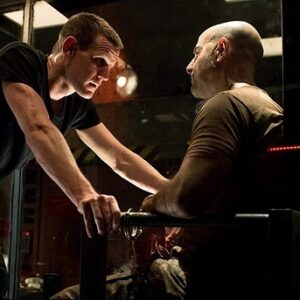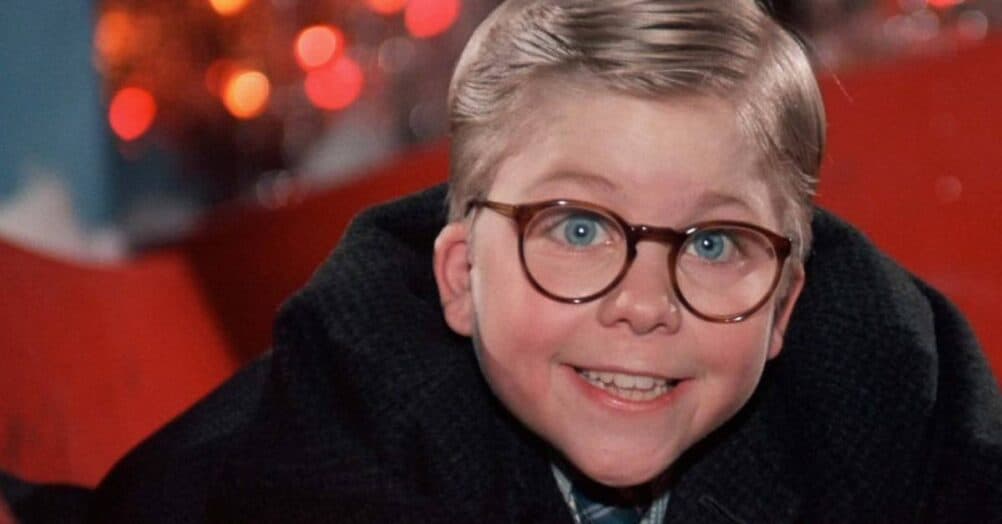
I really enjoy Neil Marshall as a director.
I loved DOG SOLDIERS, and THE DESCENT was such a fantastic horror film, that he
quickly became one to watch in my eyes. When I last talked to him he was
talking DOOMSDAY, and now, it is finally here. What could be taken by any
other director as another 28 DAYS LATER, looks to be something quite different
with Neil at the helm. He knows horror and he knows suspense. He has
a knack for creating edge of your seat entertainment.
When I sat down with him at the Sofitel Hotel in
Los Angeles, I was excited to speak with him… again. I respect the guy
for what he is, a wonderful director. But I like him even more because he
is quite simply a very cool gentleman. He seems to have a whole lot of
faith in DOOMSDAY, and I’m glad to hear it. We’ll see how the weekend
box office shapes up, but if you are looking for The Reaper… check out
DOOMSDAY, this Friday at a theatre near you.
Neil Marshall

Neil, obviously you are dealing with a much
grander scale than before, compared to THE DESCENT and DOG SOLDIERS, this looks
huge.
Certainly compared to my previous films it was
huge. It was like, ten times bigger, well, budget wise it’s ten times
bigger.
How much of a challenge was it?
Well, initially going in I thought it would be
more difficult. I thought it would be quite daunting. But once I
actually got into it, the process is exactly the same, it’s just that the
numbers are bigger, that’s all. So I absolutely loved it and by the end
of it, I just couldn’t get enough of the sheer scale of it. Having all
the gear, all the toys.
Dealing with all the extras, right?
Yeah, dealing with the extras which again, I
thought would be a pain, but it was great. They were excellent. In
one scene we had a thousand extras, which is, you know, I only ever used like
three before [Laughing]. It was great, I loved it. I couldn’t get
enough of the scale of it. We had this huge… it was actually part of a
theme park, it was this huge auditorium. And we dressed the whole thing.
We had fire and amazing props all over the place. And thousands of extras
and a stage show going on with pole dancers and this hero guy who is like giving
this speech. It was just epic and I really got into it.

In one sequence you are dealing with an
on-screen, ten minute stunt. No CGI, it was all the real thing. Was
there ever a fight with the studio about going more towards CGI?
It was always in the cards from the beginning.
I always said to everybody that this is the film I want to make. So I want
to do it with stunts, I want to do it with real stunt guys doing really
dangerous stuff. I don’t want to use green screen, I don’t want to use
CG. We did use a little CG throughout the film, just to enhance the world
and expand the world with matte paintings and a couple composites, stuff like
that. But certainly no animation because it’s just never going to look
as good as reality. And when you’ve got people who are willing to do
this kind of stuff, then I’d rather do that.
When CG is used solely to enhance it, you
don’t notice it as much.
CGI enhancing reality works, but CGI replacing
reality does not. And the human eye can tell the difference. Very
easily. You know, you can just see when something is not right. I
think the only time that I actually got into a bit of an argument was when we
were doing a scene on a train. It was just a dialogue scene on board a
moving steam train on a baggage car with the doors open. And they were
saying, ‘I don’t know how were going to light the scene. Sounds going
to be impossible. Just do it green screen, just do in a studio with full
control. Just do green screen.’ and I said no, I want to shoot it on a
real train ‘cause it’s going to look better. You know, it’s going to
look so much better. I want to shoot it with the doors open and take a
train through the wilderness and shoot. And here we had to ADR the sound
which I knew we were going to have to do anyway. But it was absolutely
worth it. It looked so much better. You know, these people really
are on a train going somewhere. So that was the big difference.
And you worked with a lot of the same people
this time.
Yeah.
Obviously you’ve added a few different
actors including Rhona Mitra. How did you work with her to prepare her for
the role?
She did like, aside from just talking about the
character and working with her on that, she did like eleven weeks of
preparation. She went to the gym, she did stunt driving and fight
choreography all kinds of stunt [work], you know, for eleven weeks prior to the
shoot. So she was in great shape by the time we shot it and prepared for
what she was going to have to undergo. And I knew that there was going to
be a few cuts and bruises along the way and there was, but she was into that.

I read in the press notes that you both
were trying to find really strong female action heroes, and you basically came
up with Linda Hamilton and Sigourney Weaver.
Yeah, I was trying to find the ones that are
tough but also have a humanity about them. It’s trying to make them
strong but never lose the femininity. And you know, Sigourney Weaver and
Linda Hamilton, for all their toughness and their ruggedness, you never
doubt for a moment that they’re women.
Especially Linda Hamilton because you never
doubt that she is a mother doing this for her child in T2. And I do think
that comes across in your films, especially in THE DESCENT.
Yeah, that was a bit different because it
wasn’t so much a strong female role, but an entire cast of strong female roles
[Laughing]. I consulted an awful lot of my friends, family, you know, any
women I could get a hold of just to say, ‘‘is this right, is this
convincing, does this ring true to you?’ ‘‘cause I wanted it to be real.
I wanted those characters to be authentic. And the same with Eden
Sinclair, Rhona Mitra, she has… her main story element, she has a strong
emotional thread and around this is this tough shell that she’s built up over
the years.
Now let’s talk about the disease. The
Reaper. How did you envision it?
I wanted it to be a real virus. When I was
writing this thing and certainly when we were filming it, everyday there was
reports about the Avian flu or SARS virus or whatever. That’s been
throughout the course of this movie. I’ve lived with it. So what I
created was just the worst possible realistic virus. It doesn’t turn
people into zombies or anything like that. And after that, it was
something that I kind of struggled with all the time, making a political
apocalyptic movie. It’s cinema law at the moment, that a virus equals
zombie. Every film that features a virus turns people into mutant zombies
or something else, or rage infected, whatever. And this film is not about
that. In this film, the virus isn’t the star of the movie. And
this virus kills people. You catch it, you start getting the sores and the
pustules and your face breaks out into a huge disgusting mess, and you bleed
from every orifice, and your internal organs liquidize, and you die. I
mean, it’s not good and it happens in twenty four hours. And it
spreads as soon as, you know, you have it for twelve hours and it’s already
contagious. By the time you realize you’ve got it, you’ve already
given it to fifty more people. So it’s the worst kind of virus.
Scary thought. Like you said, every day
in the news… how close are we to this, you know?
Well, you just need to look at the history books.
The influenza virus of 1918 or something like that, wiped out a core population
of the earth. And that was the flu. And I figure that it’s
not far off that this is going to happen, you know, at some point. And
with international travel being so easy now, it will spread like that [snaps his
fingers]. And with things like Avian flu, the whole point of them is that
nobody knows where they really came from. They just appeared. It’s
a mutant gene or whatever that suddenly becomes a virus. And there is no
explanation for it. I think that with this virus, I didn’t want to
provide an explanation for it. It just happens. It just occurs.

No scientists working in labs…
Yeah, certainly not mentioned in this.
There might be something that’s revealed in a sequel or something like that,
something man made. But I kind of liked that its just a freak of nature
like a real virus is.
Now speaking of sequels, what is your
involvement in the next Descent 2, is it happening soon?
It is happening. Its happening in the
summer.
Are you happy about it?
I don’t mind. I’m not directly involved
but I think its in good hands. The production company is the same. I
know that they won’t make something shit. And the guy that’s directing
it edited the first, I couldn’t think of a better person to do it myself.
So at least it is still in the family?
It’s very much in the family. I think
they are going to be getting the same production designer and pretty much the
same crew. I really don’t know much more about it. I’ve kind of
kept it on the sidelines and I don’t want to hassle them about it.
They’re going to do it anyways so…

Have you thought about that with DOOMSDAY?
Did you think when you were writing this about a possible sequel?
Well I had ideas for a sequel for DOG SOLDIERS
and none of that came to fruition. And if DOG SOLDIERS 2 ever does happen,
it won’t have anything to do with me and it won’t be any of my ideas.
And I was kind of burned by that a little because I did have a really good idea
for a sequel for that film and the producers just weren’t interested. So
with THE DESCENT, I never even thought about it. I had no concept of a
sequel. I actually wanted to have the film with a succinct ending.
But with DOOMSDAY, as I get a little more open minded that I’ve created a big
world and there’s more stories out there, I’m sure. There is probably
a continuation of the story that I’ve created, definitely.
SPOILER
‘Cause I’ve also done something kind of weird
which is, there are three major bad guys in the story, but only one of them dies
in the end. So there’s two kind of still left alive.
END SPOILER
We have talked about working with some of the
same people in the cast, but what about working with Bob Hoskins and Malcolm
McDowell. How did that come about?
Well Bob was first choice for that role and we
just approached him and he said yeah. It was just amazing.
Fortuitous luck or what ever you want to call it, or he just really liked the
part. So we got him on board and I never thought of anybody else for that
part. I wanted this kind of grizzled, London cop who is pissed off at the
world. In a way, his character is the most significant in the film because
he contrives or manipulates events from the start, to achieve his end, which is
just to kind of usurp the government. And he does it in such a way that
people don’t even notice that he is doing it. But he makes these things
happen, he knows exactly what he is doing. And he chooses the right people
for the job. So that was great, and I really enjoyed working with him.
And then Malcolm came in just for a week when we
were filming in Scotland. With this King Lear type of character he plays.
He is governing this castle in the islands of Scotland, living this medieval
lifestyle because its pure and its built to last, and that is kind of his ethos
throughout the whole thing. It’s just a great character and Malcolm was
just such a laugh. I couldn’t wait to just get the shooting over with so
I could just sit down and talk stories with him about Kubrick and working with
amazing people all the time. So it was a pleasure and these guys love
their job so much. You know the reason they’ve been working so long is
because they love making movies. So it was great.
Let me know what you think. Send questions
and/or comments to [email protected].




















Follow the JOBLO MOVIE NETWORK
Follow us on YOUTUBE
Follow ARROW IN THE HEAD
Follow AITH on YOUTUBE